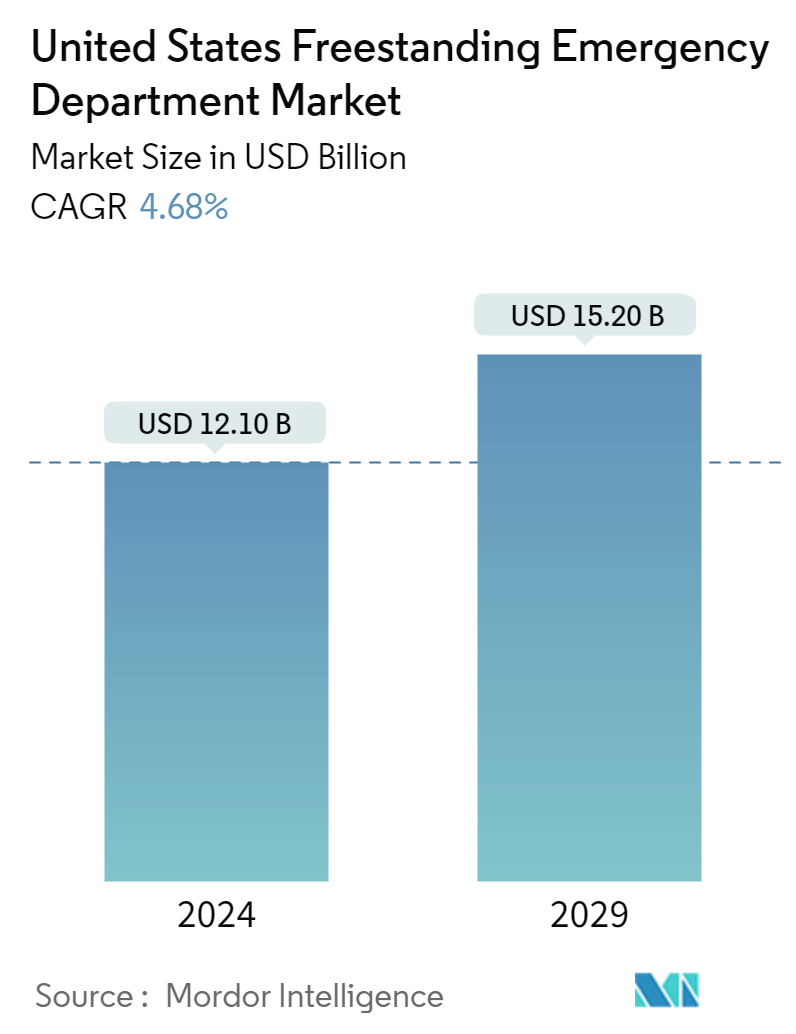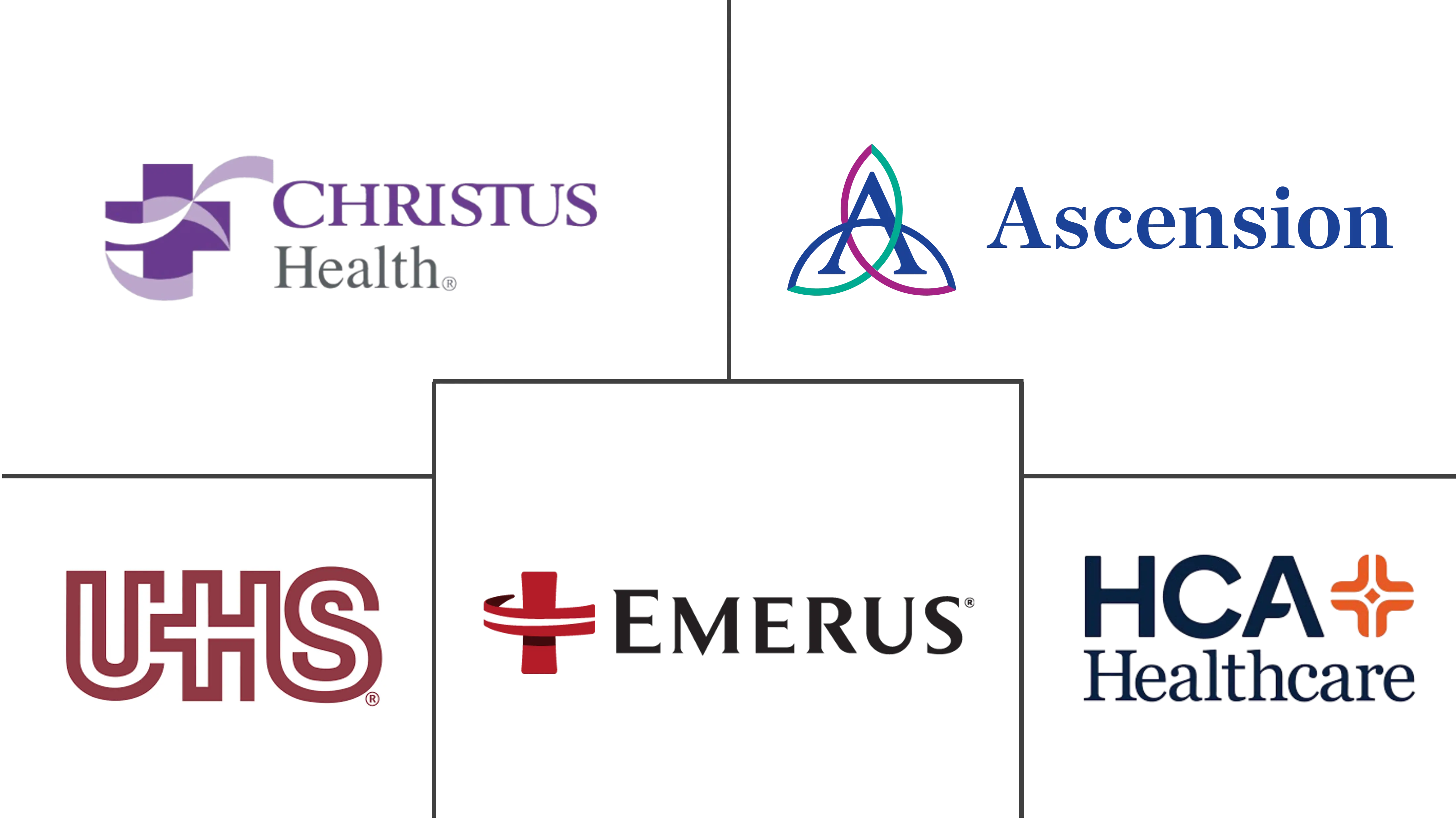Market Size of United States Freestanding Emergency Department Industry

| Study Period | 2019 - 2029 |
| Base Year For Estimation | 2023 |
| Market Size (2024) | USD 12.10 Billion |
| Market Size (2029) | USD 15.20 Billion |
| CAGR (2024 - 2029) | 4.68 % |
| Market Concentration | High |
Major Players
*Disclaimer: Major Players sorted in no particular order |
United States Freestanding Emergency Department Market Analysis
The United States Freestanding Emergency Department Market size is estimated at USD 12.10 billion in 2024, and is expected to reach USD 15.20 billion by 2029, growing at a CAGR of 4.68% during the forecast period (2024-2029).
The U.S. Freestanding Emergency Department Market (FSED) is experiencing substantial growth, propelled by evolving healthcare dynamics and shifting consumer expectations. As patient-centric care models gain traction and demand for accessible, high-quality emergency services increases, the Freestanding Emergency Department Market is undergoing a significant transformation. Two primary growth drivers—consumer-driven health plans and federal support, along with a growing preference for convenience care—are catalyzing the expansion of FSEDs across the country.
Consumer-Driven Health Plans and Federal Funding: The rapid rise of consumer-driven health plans (CDHPs) is reshaping healthcare access and affordability across the United States. CDHPs encourage patient engagement by promoting cost-conscious decision-making and enabling timely access to healthcare services. In the Freestanding Emergency Department Market, this trend encourages consumers to choose Freestanding Emergency Rooms, which offer cost-effective alternatives for acute care. Federal funding further accelerates the market's growth, as government-backed initiatives provide financial support for healthcare facilities, including Emergency Care Facilities. For example, the U.S. Department of Health and Human Services' approval of Colorado's Section 1332 State Innovation Waiver aims to expand coverage, potentially benefiting 10,000 Americans with more affordable health plans. This regulatory support widens the patient base for FSEDs, making emergency care more accessible to a broader demographic.
Rising Preference for Convenience Care: The healthcare consumer's growing demand for convenience is driving a notable shift toward Freestanding Emergency Departments. Patients value quick access, shorter wait times, and 24/7 availability, all of which are core features of FSEDs. These facilities are well-positioned to address these needs, offering high-quality emergency care without the complexity of large hospital environments. Approximately 70% of FSEDs operate round-the-clock, staffed by experienced medical personnel, making them a preferred alternative to traditional emergency rooms. In rural areas, where emergency services have historically been scarce, FSEDs are addressing a critical gap, offering timely care to underserved communities through accessible Emergency Medical Facilities.
The synergy between these key drivers—CDHPs, federal funding, and the rising demand for convenience—is creating a fertile environment for sustained growth in the U.S. Freestanding Emergency Department Market. As healthcare policies continue to evolve, and as consumer expectations shift, Freestanding Emergency Departments are poised to become a cornerstone of the modern Emergency Medical Services sector.
United States Freestanding Emergency Department Industry Segmentation
Freestanding emergency departments (FSEDs) are healthcare facilities that provide emergency services but are not located on hospital campuses. These FSEDs can be owned by hospitals or act independently. The US Freestanding Emergency Department Market is segmented by ownership type consisting of hospital affiliated and independent subsegments and by service consisting of laboratory service, imaging service, and emergency care and other services. The report offers values (USD) for the above-mentioned segments.
| By Ownership Type | |
| Hospital Affiliated | |
| Independent |
| By Service | |
| Laboratory Service | |
| Imaging Service | |
| Emergency Care and Other Services |
United States Freestanding Emergency Department Market Size Summary
The United States freestanding emergency department market is poised for significant growth, driven by factors such as an increasing number of consumer-driven health plans, federal funding, and a rising preference for convenient care options. The market is expected to expand as more Americans gain access to affordable coverage and insurers offer competitively priced plans. The government's financial support, including substantial allocations for emergency management and preparedness, further bolsters the market. The proliferation of freestanding emergency departments (FSEDs) across the country is also contributing to market expansion, as these facilities offer reduced waiting times and shorter travel distances for urgent care, attracting more patients seeking convenient emergency medical services.
The demand for FSED services is fueled by hospital overcrowding, a rise in trauma cases, and the increasing prevalence of conditions requiring prompt attention, such as strokes and neurological illnesses. These departments are equipped to handle a wide range of emergencies, including traumatic injuries, respiratory and cardiac emergencies, and acute medical conditions, making them a vital part of the healthcare infrastructure. The growing incidence of accidental and sports-related injuries, along with the rising burden of heart diseases, is expected to further drive the market. The competitive landscape features major players like Adeptus Health Inc., Ascension Health, and Universal Health Services Inc., who are expanding their presence by opening new facilities to meet the increasing demand for emergency care services.
United States Freestanding Emergency Department Market Size - Table of Contents
-
1. MARKET DYNAMICS
-
1.1 Market Overview
-
1.2 Market Drivers
-
1.2.1 Growing Number of Consumer-driven Health Plans and Federal Funding
-
1.2.2 Rising Preference for Convenience Care
-
-
1.3 Market Restraints
-
1.3.1 High Overall Expenditure
-
-
1.4 Porter's Five Forces Analysis
-
1.4.1 Threat of New Entrants
-
1.4.2 Bargaining Power of Buyers/Consumers
-
1.4.3 Bargaining Power of Suppliers
-
1.4.4 Threat of Substitute Products
-
1.4.5 Intensity of Competitive Rivalry
-
-
-
2. MARKET SEGMENTATION (Market Size by Value - USD)
-
2.1 By Ownership Type
-
2.1.1 Hospital Affiliated
-
2.1.2 Independent
-
-
2.2 By Service
-
2.2.1 Laboratory Service
-
2.2.2 Imaging Service
-
2.2.3 Emergency Care and Other Services
-
-
United States Freestanding Emergency Department Market Size FAQs
How big is the United States Freestanding Emergency Department Market?
The United States Freestanding Emergency Department Market size is expected to reach USD 12.10 billion in 2024 and grow at a CAGR of 4.68% to reach USD 15.20 billion by 2029.
What is the current United States Freestanding Emergency Department Market size?
In 2024, the United States Freestanding Emergency Department Market size is expected to reach USD 12.10 billion.

